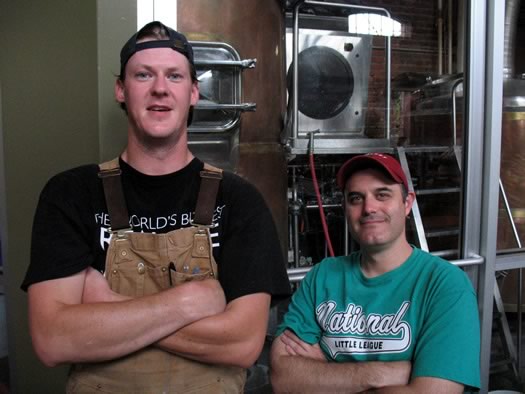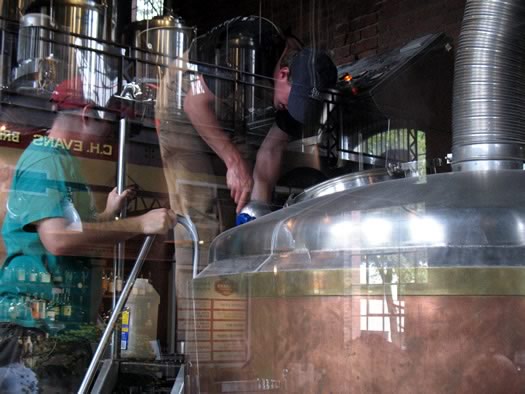Resurrecting a beer, and part of Albany's history

It turns out that resurrecting a beer that hasn't been brewed in a century is a sticky business.
Tuesday afternoon, Ryan Demler -- the brewer for C.H. Evans Brewing in Albany -- was perched atop brewing equipment trying to scrape a caramel-like form of sugar into a tank. It wasn't going well. "It's like alien goo."
The sugar -- the technical term for it is "invert sugar" -- is part of a 1901 recipe for one of the last versions of the the once-famous Albany Ale, which at one point was known around the world. Its re-creation is part of the Albany Ale Project, which is aimed at not just bringing some old beers back from the dead -- but also collecting and highlighting a key part of the city's history.

Albany has a robust brewing history. During the 19th century, the city was full of breweries. In fact, the largest brewery in the nation once stood where the UHaul building is now. And the term "Albany Ale" was known far and wide -- you could, say, walk into a bar in a Boston hotel an order an "Albany Ale."
"There's a 400-year history, but there's this 200 year period prior to the late 1800s that people have kind of forgotten about," notes Craig Gravina, a beer blogger who lives in Albany.
Intrigued by the city's brewing history -- and intent on getting the word out about it -- Gravina teamed up with fellow beer writer Alan McLeod, who lives in Canada. Gravina says he'd been doing some research a few years back on the city's "pretty spectacular" beer history and came across something McLeod had written about Albany Ale.
Their collaboration resulted in the Albany Ale Project, an attempt to pull together the many details of the city's beer history in one place. Oh, yeah, and resurrect some really old beer.

Ryan Demler and Craig Gravina
"The ultimate goal for the project, for me, is for people to realize that the history of beer in the United States starts before the 1880s," Gravina said to us while sitting at the Pump Station Tuesday afternoon. "That there's this 200 year history of beer being brewed in Albany, being brewed in the United States, that's not lager brought over by German immigrants. There's not anything wrong with that. It's just that we've forgotten that history. And if we can do that by making these beers at CH Evans, then that helps the whole thing."
That's how Ryan Demler ended up trying to scrape that sugar into the tank. Working with the Albany Institute of History and Art, the Albany Ale Project was able to turn up that 1901 recipe for Amsdell's Albany XX Ale.
"We were looking at some of the old recipes, and Neil -- the owner here -- and myself, are keen on doing New York-centric stuff and local stuff, so if there are indigenous beers here, that's really awesome," Demler told us.
The recipe looked like the easiest of the old Albany Ales to recreate, because 1) there was a recipe (though maybe a little vague in places), and 2) it didn't look like it'd be too hard to adapt it to modern brewing practices. "Plus: it looks like a pretty cool recipe. And we did get to do super geeky brewer things. Like, I've never roasted malt. ... It's an interesting exercise in adaptation."
Part of that exercise: Trying to source ingredients as similar as possible to was once used. So that meant using New York State grain, roasting the malt in house, making that (very sticky) invert sugar in house, and using hops from New York (and mostly from Albany County).

The Amsdell Albany Ale was probably the last beer to be tagged as "Albany Ale." And it represents the merging of various beer traditions into one product.
"The Albany Ale that became a phenomenon in the 1850s, it was really a British beer being made in the United States," explained Gravina. That started to change as German immigrants brought their techniques to the city's brewing industry in the late 1880s. The Amsdell Albany Ale was like a mashup of those British and German traditions. "That's what's unique about this particular beer that we're making -- it's very, very American."
So what will it taste like? Demler said it should it be malty and easy drinking, maybe closest to an English brown ale, but with higher alcohol. But, really, no one will know until it's finished. "Find me a guy who's 180 years old or whatever, and drank that beer back in 1901."
The hope is to resurrect other beers from Albany's past as part of the exploration of the city's brewing history. If possible, they'd like to work backward -- so the next beer would maybe be one from the 1850s, then the 1830s, then maybe an early Dutch beer.

Why do this?
Craig Gravina -- who's day job is a graphic designer -- describes himself as a history buff, so Albany beer history is a natural draw for him. But he also sees the Albany Ale Project as a way to help the city fill out its identity.
"To be able to connect this with the town that I live in is really special to me. Sometimes I think Albany doesn't have much of an identity other than being the state capital, and politics. ... As much as I love this city, and choose to live here, Albany's not like Buffalo, where they have chicken wings and the Bills and they're very Buffalo-centric ... We don't have that, but we did at one time," he explained. "I want people to know that history. ... I want people to know that Albany is more than the politics that goes on here, Albany is more than the Dutch. It had this great industry. And it plays so well with what's going on now with the craft beer industry."
Gravina hopes the Albany Ale Project project will end up involving a bunch of different people. The Albany Institute and C.H. Evans are already involved, as are various farms that helped provide ingredients for the re-created beer. And the Homebrew Emporium is helping with a contest for home brewers to create their own versions of the Amsdell ale based on the recipe. But Gravina said they're also looking for people to share old documents or even just family memories about Albany's brewing history.
"We still have Taylors, and Boyds, and Amsdells living in the city of Albany... they're part of this history. And we want people to not forget that."
____
The plan right now is for the first re-created beer to be available sometime around the beginning of November, not just at the Pump Station, but also at a few other bars around the city. And there will probably at least one or two events to celebrate its release, the details of which are still to come.
Hi there. Comments have been closed for this item. Still have something to say? Contact us.
Comments
My lodge brothers will attest that I'm no beer drinker, but put me down for a pint!
... said Eric Scheirer Stott on Sep 12, 2013 at 4:21 PM | link
Psyched.
... said ethan on Sep 12, 2013 at 4:28 PM | link
Can't wait to try it!
... said Chad Polenz on Sep 12, 2013 at 5:23 PM | link
I'll be first in line for a pint of this.
... said Greg on Sep 12, 2013 at 6:48 PM | link
Hey—Thanks for coming down and giving such an awesome write-up!
... said Albany Ale Craig on Sep 12, 2013 at 8:57 PM | link
Golly Gee wizz. I remenber drinking Schaeffer way back when. Remember their logo slogan? Schaeffer...... is the..... one beer to have...... when you having more than one.
Oh yes. Don't forget Hederick. It wasa brewed right there on Park Ave. across from Lincoln park.
... said Jack Donnelly on Sep 13, 2013 at 12:33 PM | link
Wow, great timing! The founder, John Taylor, died 150 years ago this past Friday. This is fantastic news!
... said Albany Archives on Sep 16, 2013 at 11:58 AM | link
We planned it that way. Okay we didn't—but thanks to Mr. Taylor anyhow!
... said Albany Ale Craig on Sep 16, 2013 at 1:35 PM | link
Great write up. Props to you for linking to the actual book passages talking about John Taylor's brewery. I will be making a trip to the Pump Station to try this brew.
... said Matt Hunt on Sep 20, 2013 at 8:11 PM | link